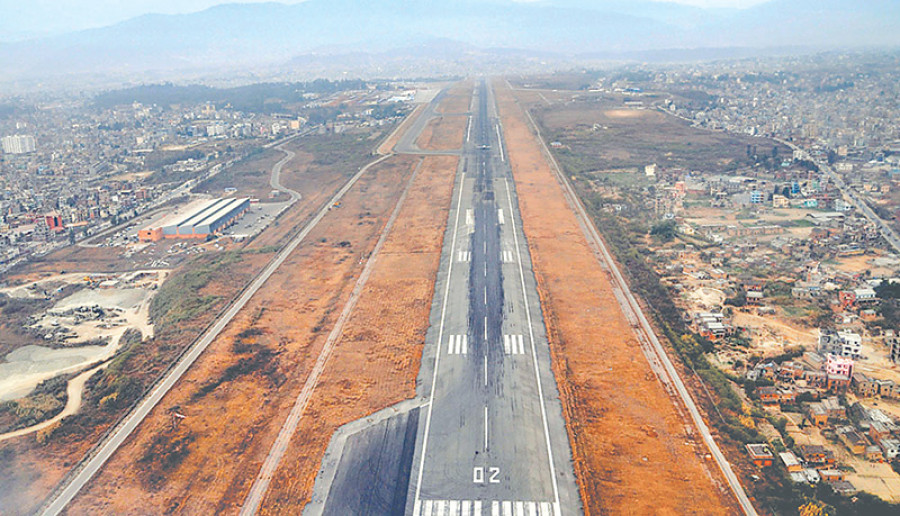Money
Chinese firm wins TIA rehab project
China’s state-owned enterprise China National Aero Technology International Engineering Corporation has appeared to be the lowest bidder to carry out the rehabilitation of more than five-decade old runway of Tribhuvan International Airport (TIA).
China’s state-owned enterprise China National Aero Technology International Engineering Corporation has appeared to be the lowest bidder to carry out the rehabilitation of more than five-decade old runway of Tribhuvan International Airport (TIA).
There were other three prequalified companies vying for the project: China Harbor Engineering, Beijing Changdao Municipal Engineering Group and a Nepali-Chinese joint venture consisting of China Railway No 5 Engineering Group and Swachchhanda Nirman Sewa.
Sanjiv Gautam, director general of the Civil Aviation Authority of Nepal (Caan), said that they have issued notice of intent for approval of bid inviting the lowest bidder to sign a contract of the Rs3.55 billion runway and taxiway rehabilitation project on Friday.
“The contract is expected to be signed before the Tihar festival,” he said. Renovation of the 3,050-metre runway will take at least five months. The runway at TIA will be closed for 10 hours daily from February or March to carry out rehabilitation works.
According to Gautam, they have targeted to complete the “critical part” of around 1,600 metres of runway from the southern side by June.
Airport authorities moved to improve the runway due to extreme pressure following frequent cracks in the
pavement that have raised safety concerns.
“The TIA runway is the most sensitive zone as we have only a single runway. Hence, we will let a contractor enter the site after being assured that it has supplied 60 percent of construction materials with sufficient manpower,” Gautam said.
The winning contractor will be given four months to make preparations.
He said that Caan has a study report of every section of the runway and its strengths. “Based on the details, the weak section of the runway will be dug out with milling machine and then pave the section with asphalt,” he said.
In 2014, authorities put the TIA runway rehabilitation project on hold until the construction of Bhairahawa International Airport was completed after being frustrated by its intermittent progress. The design to rehabilitate the runway was prepared in 2014, but the project decided to review it after the earthquake of April 2015.
For the last six years, aircraft weighing more than 196 tonnes have been barred from landing at the TIA to prevent further damage to the runway. The old runway has been affecting smooth operation of aircraft due to repeated occurrences of cracks in the pavement.
While cracks and uneven surfaces can cause dangerous take-offs and landings, airline officials said they had been facing hours-long delays almost every day during the rainy season, frustrating travellers and causing financial distress among airlines.
Scores of flights have been diverted or delayed in recent years due to problems in the runway. Trouble mainly occurs during the rainy season. This monsoon, the runway has developed cracks more than 20 times, according to airline operators.
A study conducted by Caan in 2014 had concluded that the runway at TIA was not strong enough to handle wide-body jets due to its ageing asphalt foundation, and distress is caused to the upper surface instantly when heavy planes land on it. Repeated occurrences of cracks on the runway have been affecting smooth operation of aircraft since 2011.
When compared to the core part of the runway between 2006 and 2013, damage to the intermediate layers was caused by the operation of large jets like the Airbus A330 and Boeing 777, according to Caan.
In 2013, there were 1,000 operations of A330-300 aircraft, 955 of Boeing 777 and 452 of A330-200, and the numbers are expected to double in the next 20 years.
Cracks first appeared on the runway in June 2011, and they have become a recurrent problem. Cracks were reported occasionally in 2012. However, the problem worsened in 2013, forcing Caan to take a harsh decision to bar aircraft weighing more than 196 tonnes from landing at TIA for a month.




 14.12°C Kathmandu
14.12°C Kathmandu












%20(1).jpg&w=300&height=200)
